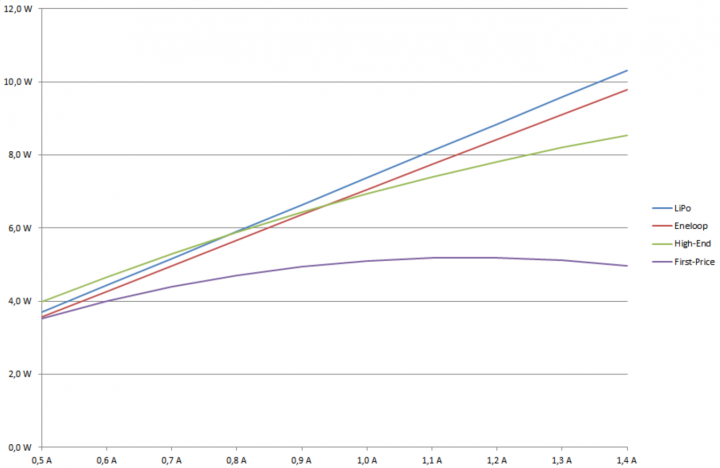A theoretical exercise I made this morning...
1) Each type of battery has 1) a nominal voltage (1.2 to 1.5V in our case) and 2) an internal resistance that should be as low as possible
2) The current draw is defined by the load (the motors in our case)
3) The question is to know how much electric power a BB can deliver for a given load, i.e. a given current draw.
6 Standard, non rechargeable batteries, deliver 9V. LiPo is at 7,4V, Eneloops at 7,2V.
Note that the Lego LiPo BB is limited to 1A (1000mA). I have personally removed the current limiter from my standard AA & AAA BB's: the batteries do what they can.
I have made the following assumptions:
- A LiPo element has a very low internal resistance - something like 0.004 Ohms per element
- Eneloop rechargeable batteries: 0,025 Ohms, based on what Google told me
- Duracell high-end batteries (Ultra Power, Power Plus, etc...) are around 0,350 Ohms
- Cheap alcaline batteries are around 0,650 Ohms
Here's the result:

[blockquote]Alvaro Soldevilla said:
I use a battery pack of 8 units 1.2 volt batteries. Are 9.6, but freshly charged are more than 10 volts, with a capacity of 1900 mAh or more.
[/blockquote]
I think that's the most reasonable approach with 1.2V batteries. The challenge now is to pack the 8 batteries in a standard Lego BB... Don't know if it can fit ?
What about speed tests ? Did you try to build a fast chassis with your battery pack ?
Marc
We still need to test the peak / continous current values, but if 3A really is what the SBrick can do, than yes, you can connect pretty much anything to it.
Of course, there is the back EMF, which need to be considered there. Large inductive loads can kick back hard, I have to check the ICs datasheet to be able to tell what impedances can be driven with it.
Hi Christian,
probably none. Maybe the LiPo battery box can supply the most current as it seems that it lacks short-circut protection (therefore current limiting) on the power pins. We used LiPo battery boxes in our racing car model, and it did very well.
However I suspect that even these batteries would die or get damaged under such load. If someone would really want to control a lage amount of high power consumers, I would recommend building a custom power supply from a general purpose, high current LiPo/LiFe battery and a PF cable.
We're manufacturing the last prototypes, and as long as the motor driver ICs go, they can put out as much as 3 amperes per channel. However the SBrick as a whole would probably get too hot too quickly if someone would draw all the 12 amperes for an extended period of time. Such high current would even warm the cables :D (Well, actually since the ground and power traces are huge, almost uninterrupted copper sheets on the PCB, we just might be able to get near that current rating :) ).
This nonsensical amount of current bearing capacity is a side effect of the solution to the M motor problem: the motors have large capacitros that need to be charged very quickly, so the electronics must endure big current spikes for a few microseconds.
Because all this, SBrick is amazingly power-user and hacker friendly, it has a tremendous tuning potential. Since we will open the BLE protocol, and you can open the enclosure (there goes your warranty of course ;) ), you can quickly get yourself a device that can drive quite a lot more than PF motors. Of course, this all means that you probably won't be able to get the max out with just LEGO power supplies.